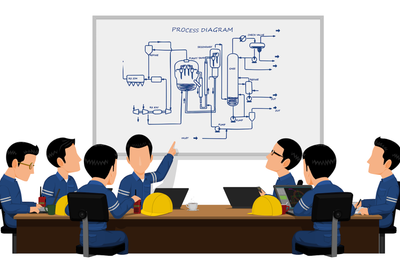The plant had begun to experience a strange rash of pneumatic and instrumentation failures after a week of heavy thunderstorms. The instrument technicians were finding oily water in various failed solenoids, I/P transducers and pneumatic blocks. The operations group was growing impatient with what seemed like a constant string of problems and, in their opinion, the recently created ultrasound leak detection program was to blame.
A couple of months prior, the maintenance department was determined to get the plant’s compressed air leaks under control to rein in the maintenance costs associated with the plant’s air compressors. All the air compressors were running to failure and had to be either replaced or rebuilt on an emergency basis. The maintenance manager allowed for the creation of an ultrasound program, with the primary focus of eliminating all compressed gas leaks within the facility, air leaks being chief among them. Technicians were trained, equipment was purchased, routes were established, and reporting documentation was created. This recent trend of failures associated with the air system had shaken the facility’s confidence in whether an ultrasound program was a good idea.
As the dispute over the cause of the pneumatic and instrumentation failures wasn’t readily apparent, the reliability engineer was tasked with performing an RCA. A close inspection of the failed equipment showed that the immediate cause of the failures was an oil and water mixture in the compressed air that either clogged or shorted out the equipment. This was perplexing as the compressed air system was outfitted with resonance tanks, refrigerant dryers, desiccant dryers, filter mat stations, and air blows before the air would even reach the equipment. This equipment was under the operations group and didn’t have any kind of reported issues.
The step was to shadow the technician as the ultrasound route was performed. As the technician went into the area, there were audible air leaks all throughout, with some coming from manual drain valves that were cracked open. The reliability engineer observed that the air pressure for the area was barely above the minimum required to allow the systems to operate, just about 80psi. As the technician performed the route, leaks were identified, marked and tagged for future repair, while others could be corrected immediately, such as the cracked drain valves. The air pressure in the area rose to 95psi. The technician remarked that the drain valves were almost always open everywhere he goes. As the route concluded, reports were created and put into the CMMS for those leaks that could not be immediately addressed.
The reliability engineer questioned the area’s operators and supervisors about the drain valves. The main consensus was that the area’s operations had grown accustomed to having the compressed air’s drain valves open to clear out any residual oil or water in the compressed air. The direct response from the lead operator about why you open the compressed air drain valve and not address the air dryers was, “It’s supposed to sound that way.” This caused air pressure in the area to drop significantly. The operators would compensate for this by bypassing the air dryers. So, when the technician would close the drain valves, water and oil would build up in the air system and cause issues. Therefore, there would never have been any issues reported about the air dryers possibly not working nor any communication that the system was purposely being run in this fashion. The operations group only saw that the technician was closing the drain valves and, therefore, causing the failures.
When the RCA’s findings were presented to the management group, the operations manager disavowed any responsibility over the condition of the compressed air system, contradicting the established processes and procedures, as it was his belief that if the system ran, it was fine, and if there was a problem, maintenance needed to address it. The ownership of the compressed air system was transferred from the operations group to the maintenance group as a result. The issues with the water removal system were addressed, the drain valves were closed, and the failures abated.
